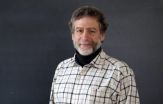(Press-News.org) LA JOLLA, CA---- By reprogramming skin cells from Parkinson's disease patients with a known genetic mutation, researchers at the Salk Institute for Biological Studies have identified damage to neural stem cells as a powerful player in the disease. The findings, reported online October 17th in Nature, may lead to new ways to diagnose and treat the disease.
The scientists found that a common mutation to a gene that produce the enzyme LRRK2, which is responsible for both familial and sporadic cases of Parkinson's disease, deforms the membrane surrounding the nucleus of a neural stem cell. Damaging the nuclear architecture leads to destruction of these powerful cells, as well as their decreased ability to spawn functional neurons, such as the ones that respond to dopamine.
The researchers checked their laboratory findings with brain samples from Parkinson's disease patients and found the same nuclear envelope impairment.
"This discovery helps explain how Parkinson's disease, which has been traditionally associated with loss of neurons that produce dopamine and subsequent motor impairment, could lead to locomotor dysfunction and other common non-motor manifestations, such as depression and anxiety," says Juan Carlos Izpisua Belmonte, a professor in Salk's Gene Expression Laboratory, who led the research team. "Similarly, current clinical trials explore the possibility of neural stem cell transplantation to compensate for dopamine deficits. Our work provides the platform for similar trials by using patient-specific corrected cells. It identifies degeneration of the nucleus as a previously unknown player in Parkinson's."
Although the researchers say that they don't yet know whether these nuclear aberrations cause Parkinson's disease or are a consequence of it, they say the discovery could offer clues about potential new therapeutic approaches.
For example, they were able to use targeted gene-editing technologies to correct the mutation in patient's nuclear stem cells. This genetic correction repaired the disorganization of the nuclear envelope, and improved overall survival and functioning of the neural stem cells.
They were also able to chemically inhibit damage to the nucleus, producing the same results seen with genetic correction. "This opens the door for drug treatment of Parkinson's disease patients who have this genetic mutation," says Belmonte.
The new finding may also help clinicians better diagnose this form of Parkinson's disease, he adds. "Due to the striking appearance in patient samples, nuclear deformation parameters could add to the pool of diagnostic features for Parkinson's disease," he says.
The research team, which included scientists from China, Spain, and the University of California, San Diego, and Scripps Research Institute, made their discoveries using human induced pluripotent stem cells (iPSCs). These cells are similar to natural stem cells, such as embryonic stem cells, except that they are derived from adult cells. While generation of these cells has raised expectations within the biomedical community due to their transplant potential----the idea that they could morph into tissue that needs to be replaced----they also provide exceptional research opportunities, says Belmonte.
"We can model disease using these cells in ways that are not possible using traditional research methods, such as established cell lines, primary cultures and animal models," he says.
In this study, the researchers used skin fibroblast cells taken from Parkinson's disease patients who have the LRRK2 mutation, and they reprogrammed them to iPSC stem cells and developed them into neural stem cells.
Then, by using an approach to model what happens when these neural stem cells aged, they found that older Parkinson disease neural stem cells increasingly displayed deformed nuclear envelopes and nuclear architecture. "This means that, over time, the LRRK2 mutation affects the nucleus of neural stem cells, hampering both their survival and their ability to produce neurons," Belmonte says.
"It is the first time to our knowledge that human neural stem cells have been shown to be affected during Parkinson's pathology due to aberrant LRRK2," he says. "Before development of these reprogramming technologies, studies on human neural stem cells were elusive because they needed to be isolated directly from the brain."
Belmonte speculates that the dysfunctional neural stem cell pools that result from the LRRK2 mutation might contribute to other health issues associated with this form of Parkinson's disease, such as depression, anxiety and the inability to detect smells.
Finally, the study shows that these reprogramming technologies are very useful for modeling disease as well as dysfunction caused by aging, Belmonte says.
INFORMATION:
Other researchers on the study were: Guang-Hui Liu, Jing Qu, Keiichiro Suzuki, Emmanuel Nivet, Mo Li, Nuria Montserrat, Fei Yi. Xiuling Xu, Sergio Ruiz, Weiqi Zhang, Bing Ren, Ulrich Wagner, Audrey Kim, Ying Li, April Goebl, Jessica Kim, Rupa Devi Soligalla, Ilir Dubova, James Thompson, John Yates III, Concepcion Rodriguez Esteban, and Ignacio Sancho-Martinez.
The research was supported by Glenn Foundation for Medical Research, G. Harold and Leila Y. Mathers Charitable Foundation, Sanofi, The California Institute of Regenerative Medicine, Ellison Medical Foundation and Leona M. and Harry B. Helmsley Charitable Trust, MINECO and Fundacion Cellex.
About the Salk Institute for Biological Studies:
The Salk Institute for Biological Studies is one of the world's preeminent basic research institutions, where internationally renowned faculty probe fundamental life science questions in a unique, collaborative, and creative environment. Focused both on discovery and on mentoring future generations of researchers, Salk scientists make groundbreaking contributions to our understanding of cancer, aging, Alzheimer's, diabetes and infectious diseases by studying neuroscience, genetics, cell and plant biology, and related disciplines.
Faculty achievements have been recognized with numerous honors, including Nobel Prizes and memberships in the National Academy of Sciences. Founded in 1960 by polio vaccine pioneer Jonas Salk, M.D., the Institute is an independent nonprofit organization and architectural landmark.
Salk scientists pinpoint key player in Parkinson's disease neuron loss
Stem cell study may help to unravel how a genetic mutation leads to Parkinson's symptoms
2012-10-20
ELSE PRESS RELEASES FROM THIS DATE:
Daily vibration may combat prediabetes in youth
2012-10-20
AUGUSTA, Ga. – Daily sessions of whole-body vibration may combat prediabetes in adolescents, dramatically reducing inflammation, average blood glucose levels and symptoms such as frequent urination, researchers report.
In mice that mimic over-eating adolescents headed toward diabetes, 20 minutes of daily vibration for eight weeks restored a healthy balance of key pro- and anti-inflammatory mediators and was better than prescription drugs at reducing levels of hemoglobin A1c, the most accurate indicator of average blood glucose levels, said Dr. Jack C. Yu, Chief of the ...
Disk galaxies formed gradually, astronomers find from images, computer simulations, and spectra
2012-10-20
Spectroscopic observations of distant galaxies taken with the 10-meter telescopes at the W. M. Keck Observatory on Hawaii, when combined with images taken by the Hubble Space Telescope plus supercomputer simulations to help interpret the observations, together reveal a major surprise: that a standard assumption about the evolution of galaxies is not correct.
Astronomers had thought that disk galaxies (like our own Milky Way) had largely finished forming by about 8 billion years ago, as indicated by the rates at which stars are formed in the Universe. Therefore, many astronomers ...
Science reveals the power of a handshake
2012-10-20
New neuroscience research is confirming an old adage about the power of a handshake: strangers do form a better impression of those who proffer their hand in greeting.
A firm, friendly handshake has long been recommended in the business world as a way to make a good first impression, and the greeting is thought to date to ancient times as a way of showing a stranger you had no weapons. Now, a paper published online and for the December print issue of the Journal of Cognitive Neuroscience on a study of the neural correlates of a handshake is giving insight into just ...
Dartmouth researchers explore how the brain perceives direction and location
2012-10-20
The Who asked "who are you?" but Dartmouth neurobiologist Jeffrey Taube asks "where are you?" and "where are you going?" Taube is not asking philosophical or theological questions. Rather, he is investigating nerve cells in the brain that function in establishing one's location and direction.
Taube, a professor in the Department of Psychological and Brain Sciences, is using microelectrodes to record the activity of cells in a rat's brain that make possible spatial navigation—how the rat gets from one place to another—from "here" to "there." But before embarking to go ...
NASA sees extra-large, now extra-tropical storm Prapiroon fading
2012-10-20
Prapiroon is both extra-large and now extra-tropical in the western North Pacific Ocean. NASA's Terra satellite captured an image of the large storm after Prapiroon became extra-tropical.
The Moderate Resolution Imaging Spectroradiometer (MODIS) instrument aboard NASA's Terra satellite captured a visible image of Extra-tropical Storm Prapiroon on Oct. 19 at 01:15 UTC (Oct. 18, 9:15 p.m. EDT). The storm appeared on the MODIS image to be as large as the main island of Japan and the strongest thunderstorms and heaviest rainfall appeared north of the center of circulation ...
Astronomers uncover a surprising trend in galaxy evolution
2012-10-20
VIDEO:
A study of 544 star-forming galaxies observed by the Keck and Hubble telescopes shows that disk galaxies like our own Milky Way unexpectedly reached their current state long after much...
Click here for more information.
A comprehensive study of hundreds of galaxies observed by the Keck telescopes in Hawaii and NASA's Hubble Space Telescope has revealed an unexpected pattern of change that extends back 8 billion years, or more than half the age of the universe.
"Astronomers ...
Cholera discovery could revolutionize antibiotic delivery
2012-10-20
Contact:
Lisa Craig (Burnaby resident), 778.782.7140, licraig@sfu.ca
Carol Thorbes, PAMR, 778.782.3035, cthorbes@sfu.ca
Photos on Flickr: http://at.sfu.ca/lutURE END ...
RIT professor studies connection between child, mother mortality
2012-10-20
The death of a child is a tragic event for a family, bringing with it feelings of numbness, anger, guilt and denial. And, unfortunately, for many families, the loss becomes too much to bear.
A new study co-conducted by a researcher at Rochester Institute of Technology uncovers the strong connection between the death of a child and the mortality of the mother, regardless of cause of death, gender of the child, marital status, family size, income or education level of the mother.
Javier Espinosa, assistant professor in RIT's College of Liberal Arts and an expert in health ...
Geosphere explores the Sierra Nevada, Colorado River system, Laurentia, and the deep sea
2012-10-20
Boulder, Colo., USA – Geosphere, The Geological Society of America's peer-reviewed online journal, has added papers to four special issues: Origin and Evolution of the Sierra Nevada and Walker Lane; CRevolution 2: Origin and Evolution of the Colorado River System II; Exploring the Deep Sea and Beyond; and Making the Southern Margin of Laurentia. Geosphere specializes in accommodating animations, sound, and movie files, along with high-resolution figures.
Abstracts for these and other Geosphere papers are available at http://geosphere.gsapubs.org/. Representatives of the ...
A novel scheme to enhance local electric fields around metal nanostructures
2012-10-20
Enhanced local electric fields are predominant in nonlinear optical properties, particularly in surface-enhanced Raman scattering (SERS), which is a sensitive technique used for the detection of trace amounts of chemicals. Analysis of the electric fields around nanostructures indicates that they can provide a basic foundation to obtain greater SERS intensity. Professor ZHANG Zhongyue and his group from the College of Physics and Information Technology at Shaanxi Normal University have proposed a novel scheme to enhance the local electric fields around nanostructures. The ...
LAST 30 PRESS RELEASES:
Rare image of Tatooine-like planet is closest to its twin stars yet
Music: Popular song lyrics have become more negative since 1973
Marine ecology: Killer whales tail dolphins to hunt salmon
ADHD prescriptions on the rise, study finds
How to build a genome
Sharp rise in ADHD stimulant prescriptions in Ontario, research finds
Trends and prevalence of the metabolic syndrome among US adults
Population-level trends in ADHD medication prescribing
Missing piece of myelin disturbs the brain’s rhythm
Insilico Medicine and Taigen achieves license agreement to develop and commercialize AI-driven PHD inhibitor for anemia of Chronic Kidney Disease (CKD)
Exploring dominant endophytic Pleosporales in grasses: New taxonomic insights in the suborder Massarineae
Comparative transcriptomic analysis of human maxillary and mandibular tooth germs reveals discrepancies in gene expression patterns
Scientists detect atmosphere on molten rocky exoplanet - study
Chip-scale magnetometer uses light for high-precision magnetic sensing
Illinois Tech biomedical engineering professor Philip R. Troyk elected as Fellow of the National Academy of Inventors
The National Academy of Inventors welcomes 2025 Class of Fellows
Multi-scale modelling framework predicts mechanical responses of Fe–Cr–Al alloys across composition and processing conditions
Preoperative radiation may improve antitumor immune response in most common form of breast cancer
Breast MRI may be safely omitted from diagnostic workup in certain patients with early-stage, HR-negative breast cancer
Sentinel lymph node biopsy may be safely omitted in some patients with early-stage breast cancer
Rats may seek cannabis to cope with stress
New FAU research strengthens evidence linking alcohol use to cancer
Gut health à la CAR T
Dr. Pengfei Liu receives 2026 O'Donnell Award in Medicine for pioneering advances in genetic diagnostics and rare disease treatment
Dr. Yunsun Nam receives 2026 O'Donnell Award in Biological Sciences for pioneering RNA research transforming gene regulation and cancer therapy
Dr. Bilal Akin wins 2026 O'Donnell Award in Engineering for transformative work in EV energy systems and industrial automation
Dr. Fan Zhang receives 2026 O'Donnell Award in Physical Sciences for groundbreaking discoveries in quantum matter and topological physics
Dr. Yue Hu receives 2026 O'Donnell Award for revolutionizing energy operations with real-time AI and reinforcement learning
Greater risk that the political right falls for conspiracy theories
JMC Publication: Insilico’s AI platforms enable discovery of potent, selective, oral DGKα inhibitor to overcome checkpoint resistance
[Press-News.org] Salk scientists pinpoint key player in Parkinson's disease neuron lossStem cell study may help to unravel how a genetic mutation leads to Parkinson's symptoms




